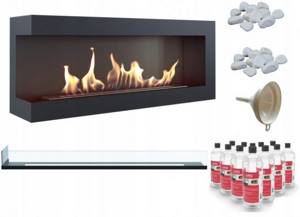Reversible screwdriver TUNDRA, with a set of bits and heads in a case, 40 items
834 ₽ More details

Set of open-end wrenches in holder TUNDRA, chrome-plated, 6 - 22 mm, 10 pcs.
803 ₽ More details
TUNDRA Tool Sets
Biofuel for the fireplace is made only from natural raw materials, which are a product of the vital activity of living organisms. It uses products of animal or plant origin. Biological waste is also often processed for these purposes. A remarkable feature of biofuel is that it is the best alternative fuel that does not require a chimney.

Eco-fireplace using biofuel does not require a chimney
basic information
This type of fuel is used only for eco-fireplaces. It received the prefix “bio” due to the use of only renewable biological products. The basis of fuel for fireplaces is denatured ethanol, which contains regular ethanol. This product is obtained through the fermentation of various sugar-containing crops.
The most common uses for ethanol production are:
- beet;
- wheat;
- sugar cane;
- potato.
Alcohol (ethanol) can be obtained by hydrolysis of raw materials containing a lot of cellulose. Straw or wood is used for this.
Rules for the safe use of fireplaces
Despite the fact that biofireplaces are one of the safest fireplaces in the home , during their operation you need to follow simple rules .
- Models with an open combustion chamber must be installed at a considerable distance from combustible objects: textile interior elements, bookshelves, curtains.
- The surface on which the fireplace is installed must be level and stable, especially for models using liquid fuel.
- You should not leave the fireplace uncontrolled or trust children to light it.
- If the fireplace is not in use for a long time, drain the fuel from it. Bioethanol must be stored in a place that prevents overheating and contact with open fire.
- Fuel can only be added to a fireplace that is extinguished and has completely cooled down.
- Ignition is carried out with a special lighter for bio-fireplaces, which prevents burns.
- Bio-fireplaces can only be decorated using elements specially designed for this purpose: stones, imitation coals and logs made of heat-resistant ceramics.
- Built-in models must be installed in niches made of fire-resistant materials. You can find out how to make a niche with a brick arch in this article, in the section for stoves and a brick arch. Here we talk about models of cast iron stoves that have an attractive design similar to a fireplace, allowing you to admire an open fire, but at the same time they are an excellent heating unit. If you follow the safety rules, using a biofuel fireplace in your home is completely safe.
Considering the numerous advantages and minor disadvantages, biofireplaces have every chance of winning a strong place among designers and owners of stylish apartments and cottages. Their installation and operation does not require extensive repair work; you just need to choose a model according to your taste and financial capabilities.
Biofuel properties
During denaturation, ethanol becomes environmentally neutral. It does not cause harm to human health, since during combustion it releases heat and some carbon monoxide. The use of biofuel allows you not only to maintain health, but also to obtain beautiful and even flames when burning in a fireplace.
This is interesting: the difference between liquid for a biofireplace and conventional fuel.
Biofuels are absolutely safe for health and the environment. During combustion, it does not produce smoke or soot. This allows you to build a fireplace without a hood or chimney. When burning, a lot of heat is released, which remains in the house for a long time. The efficiency of biofuel reaches 95%. If you compare the flames from burning such fuel and wood, there are practically no differences.
Another advantage in favor of using biofuel is its release form. It comes in gel form, which is very convenient to use and store. It also contains sea salt. It allows you to achieve crackling, like regular firewood, during combustion.

Biofuel is absolutely safe for the health of people, animals and the environment
How biogas is produced
This type of fuel differs significantly from the bioethanol described above in composition, method of production and use. If desired, such a flammable substance can be produced on your own site. This gas is not suitable for an eco-fireplace, but it is quite successfully used for ordinary fireplaces equipped with special burners.

A biogas production plant is a sealed container into which raw materials are loaded and converted into a combustible mixture for heating homes or utility rooms.
Through them, not only biogas enters the combustion chamber, but also an additional flow of oxygen. This way you can ensure efficient combustion of biofuels. A fireplace intended to use biogas must have a chimney. This allows it to be used not only for burning gas, but also for more traditional types of fuel: wood, coal, etc.
If the house already has a fireplace, converting it to use biogas will not be particularly difficult. If you have enough firewood, you can make your own charcoal to save some money. It is possible to produce biogas from manure.
It must be mixed with products of plant origin: straw, peat, tree leaves, vegetable tops, sawdust, etc. This mixture is placed in a tightly closed container, where it ferments under the influence of bacterial cultures.
The result is a flammable gas that consists mainly of methane. It can be burned to heat residential premises, greenhouses, and utility rooms.
One of the mandatory requirements for a biogas plant is absolute tightness. Since the process is accompanied by the release of a characteristic stench, the fermentation container is installed underground.
A hose is brought outside through which the resulting gas flows. Another hose is needed to feed material inside for recycling. You can make a biogas generator yourself, but there are also industrial models that are safer and more productive.
Types of fuel
Biofuel is produced mainly in Europe and America. But Brazil occupies the leading place in its production. All fuels produced in the world can be divided into several types:
- biodiesel;
- bioethanol;
- biogas.
The first type of fuel is made from vegetable oils. Biogas is a kind of replacement for conventional gas produced during the processing of waste and household waste. Biodiesel also contains ethanol and easily replaces regular gasoline.

Biodiesel is produced during the processing of waste and household waste
Biodiesel is the best choice for a fireplace. For its production, vegetable oils of animal or microbial origin are used. The main composition of biofuels for fireplaces includes oils from:
- soy;
- palm trees;
- coconut;
- rapeseed

Biofuels are made from foods that contain a lot of sugar and starch.
In the production of fuel, the technology of processing ordinary algae is often used. This is mainly practiced by European manufacturers.
Almost any biofuel found can be represented by bioethanol. This ingredient is an alcohol that is formed during the fermentation and processing of carbohydrates. For this purpose, products that contain a lot of sugar and starch are used. Cellulose-containing raw materials can also be used. The finished liquid is colorless and should be odorless.
Popular brands and manufacturers
Biofuels are produced in many countries around the world. Production is established in Spain, Germany, France, Italy, North and South America. Fuel is also produced on the African continent. About 5% comes from India and China. Brazil occupies the leading place. Also, several factories have been opened in Russia. All of these countries have sufficient quantities of plant materials needed to make ethanol. Fuel for biofireplaces is available for sale from the following brands:
- Kratki BioDECO - Polish fuel, produced in 1 liter bottles, which lasts up to 5 hours of combustion;
- InterFlame - country of origin: Russia, volume 1 liter, operating time 2-5 hours;
- BioKer - Russian biofuel is sold in economical 5 liter containers, which will last up to 20 hours of combustion at an average consumption of 0.3 l/hour;
- Planika Fanola is a German manufacturer and is available in bottles from 1 to 5 liters. Fuel consumption per hour is 2-6 hours depending on the intensity of combustion. Thermal power is about 3 kW;
- Vegeflame - fuel produced in France. A 5 liter canister lasts from 15 to 20 hours at a consumption of 0.3 l/hour;
- Bionlov is a Swiss biofuel for fireplaces without synthetic additives. A volume of 1 liter is enough for continuous burning for up to 5 hours;
- Bioteplo Slimfire - Italian quality biofuel allows you to provide a fireplace with fire for up to 5 hours. Material consumption is 0.36 l/hour.

As you can see, there is plenty to choose from. The cost of fuel depends on the brand, container volume, presence of impurities and fragrances. Some aromatic oils are quite expensive, although their quantity in the composition is extremely small. On average, you will have to pay from 300 to 700 rubles for 1 liter of raw materials.
Fuel Features
A remarkable advantage of using such fuel is the minute amount of soot. When burned in a fireplace, no more soot is formed than from a burnt candle. There is also no carbon monoxide, which is harmful to health.
When using bioethanol in a fireplace, some water and a small amount of carbon dioxide are formed. This is the reason for the absence of the usual orange flame.
To achieve maximum naturalness, additives are added to bioethanol , which give the flames a characteristic orange tint. They also help to achieve maximum naturalness of the flame.
Safety rules for using a biofireplace

Even when installing a bio-fireplace in your home, instead of a conventional one, you must also follow safety rules. In heating devices of this type, real fire also burns. The fuel consists of alcohol.
Considering all this, it is necessary to take precautions. They are as follows:
- Pouring alcohol into the fuel tank is only allowed if the fireplace is completely cool.
- Do not add fuel to the fireplace while it is operating.
- Do not fill the fuel tank to the brim. The norm is when the fuel is filled to one third.
- Fire can only be lit with special tools designed for ignition.
- It is unacceptable to use straw, wood splinters, paper, etc. for lighting.
- Biofuel should only be stored in safe places and always away from children and animals.
- Do not leave alcohol in the tank if the fireplace is not currently in use.
- Under no circumstances should children be allowed to light the fireplace.
- If biofuel is accidentally spilled, wipe the area dry immediately.
- We must remember that the bio-fireplace and fuel should not be located nearby. Biofuels should be stored away from heating devices.
- It is unacceptable to dilute the standard with other flammable substances.
- If any of the people living in the house have diseases associated with the respiratory tract, then before purchasing a biofireplace, you should definitely consult a doctor.
- You should not experiment with aromatherapy. When there is too much essential oil, it can affect your well-being and disrupt the combustion process of biofuels.
The operating rules are simple. If you use the device correctly, it will last a long time and will be completely safe for people.
DIY making
If you wish, you can make biofuel for the fireplace with your own hands. Ethanol, the main component of fuel, can be freely purchased at the pharmacy. The alcohol concentration in purchased raw materials will vary between 90-96%. Cooking fuel at home is a simple process that will not cause problems. To obtain coloring, you can use regular refined gasoline, which is used in lighters. To check its quality, just look and smell the substance. It should be transparent and odorless.
To prepare biofuel, you need to mix 1 liter of ethanol and 100 g of gasoline. You need to use such a product as quickly as possible, since after a while it will begin to delaminate.
According to statistics, a properly prepared product has extremely low consumption and very high efficiency. A home fireplace will consume no more than 400 g of fuel per hour of operation.
Original burner
We have already looked at how to make a burner for a bio-fireplace as close as possible to the one that is produced at enterprises, but there is another design option that allows you to make an almost disposable bio-fireplace in a couple of minutes.
The simplest burner for a biofireplace
To do this, a reservoir for alcohol is created, directly connected to the combustion area by making holes in the lid. The tank is filled with mineral wool and filled with alcohol. To create a small burner, you can take an ordinary iron can with a lid. Next, the area above the holes is set on fire, and we have at our disposal a simple, small bio-fireplace. Such a device for a biofireplace burner will allow you to create a romantic atmosphere with your own hands in literally a matter of minutes.
Choose cotton-like white glass wool, as this option is the most environmentally friendly because. made on acrylic base. The density of the cotton wool does not play a big role, but it is desirable that it be soft. When filling the tank, do not compact the filler too much.
We hope that now you understand how to make a burner for a bio-fireplace with your own hands, and you understand that there is nothing particularly difficult in this process. The most important thing is to show your imagination, work out the safety of the device and take into account the nuances of joining its elements during assembly.











